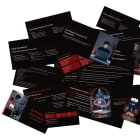How to Build a Lean Startup Using AI Tools: Frameworks for Solopreneurs
How to validate ideas, build MVPs, and scale operations without hiring a team
The lean startup method just got an AI upgrade. Solo founders are now validating assumptions in days (not months), automating operations that used to need teams, and running systematic growth experiments on $500 budgets. Here’s the playbook.
A brandable Workshop Kit is available for this article. Not yet a Coach-level Subscriber? Find out about the Workshops…
You don’t need a team of 10 to build like one. You need the right AI tools, lean principles, and systematic thinking.
Hey there, 👋
Most solopreneurs are building startups the hard way. They’re either burning out trying to do everything manually, or they’re throwing money at tools and freelancers they can’t afford. Meanwhile, AI-native founders are moving faster, validating ideas cheaply, and scaling solo operations that used to require entire teams.
The difference is systematic thinking combined with AI leverage.
This guide shows you exactly how to apply lean startup principles enhanced by AI, from validating your idea in days instead of months, to building operations that scale without hiring.
These aren’t generic AI tips, these are structured frameworks you can implement this week.
The Solo Founder’s Real Problem
When you’re building alone, every hour matters. You’re juggling product development, customer acquisition, support, marketing, sales, and somehow trying to maintain the vision that made you start this journey.
Traditional lean startup advice assumes you have a co-founder or early team members.
Traditional AI advice assumes you have time to experiment with dozens of tools.
You have neither luxury.
You need frameworks that help you make faster decisions about where to invest your limited time and money.
You need to know which assumptions to test before you waste months building the wrong thing.
You need to identify which parts of your business to automate with AI versus where you need to stay hands-on.
And you need systematic experiments that tell you what growth channels actually work for your specific business.
Most importantly, you need to do all of this without burning out in 90 days.
Framework 1: Defining Your Lean MVP with AI
The biggest mistake solopreneurs make is building too much before talking to customers. The second biggest mistake is building too little and calling it validation.
AI can help you find the precise middle ground, the minimum feature set that delivers real value while staying within your solo constraints.
Use this prompt to define your lean MVP:
I’m a solopreneur building a lean startup and need to define my MVP. Help me apply lean principles with AI enhancement.
Business Idea: [Your startup concept in 2-3 sentences]
Target Customer: [Who you’re solving for]
Core Problem: [What problem you’re solving]
Available Resources: [Time, budget, skills you have]
Timeline Goal: [When you want to launch]
Please help me:
1. CORE VALUE PROPOSITION: What is the single most essential value this product must deliver to solve the core problem? Strip away all nice-to-haves.
2. MINIMUM FEATURE SET: What is the absolute minimum set of features needed to deliver that core value? List only features that directly enable the core value proposition.
3. BUILD VS. NO-CODE: For each feature, should I build it custom or use existing no-code tools? Consider my solo constraints.
4. VALIDATION APPROACH: What’s the cheapest, fastest way to validate this MVP idea before building anything?
5. LAUNCH TIMELINE: Given my resources, what’s a realistic timeline to get this MVP in front of real users?
Focus on what I can execute alone in the next 30-60 days, not what a funded team would build.
The key is asking AI to optimize for what you can execute alone in 30 to 60 days, not what a funded team would build. When you frame the question this way, AI stops giving you ambitious roadmaps and starts giving you executable plans.
For example, if you’re building a project management tool for freelance designers, AI might help you realize your core value proposition isn’t “comprehensive project management” but “client communication that makes you look professional.” That distinction changes everything. Now your MVP isn’t 15 features, it’s 3 features that nail that specific outcome.
The output should make you slightly uncomfortable because it feels too minimal. That’s the point. Your first version should make you mildly embarrassed when you show it to people. If it doesn’t, you’ve built too much.
Framework 2: Optimizing Your Time and Money
As a solopreneur, you have competing priorities pulling you in five directions simultaneously. Product development needs attention. Customer acquisition can’t wait. Content marketing takes time. Sales outreach requires consistency. Learning new skills seems urgent. Without a systematic way to allocate resources, you’ll spend six months being busy without making real progress.
Use this prompt to optimize your resource allocation:

